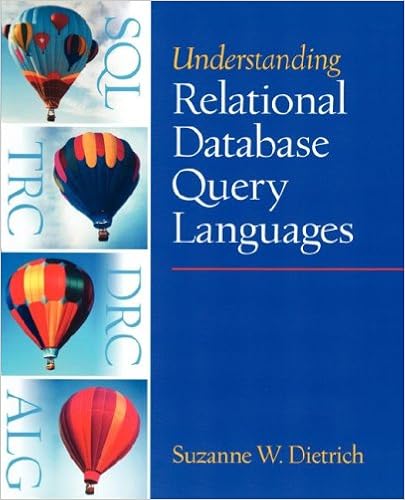
Free Downloads Understanding Relational Database Query Languages

This invaluable learning tool provides an understanding of the industry-standard query language SQL. Using an appropriate mix of underlying mathematical formalism and hands-on activities with numerous examples, the book is designed to help users grasp the essential concepts of relational database query languages. The book provides a complete presentation of the relational data model, relational algebra, domain and tuple relational calculus and SQL, with case studies and Microsoft assess. For individuals in computer science, information services and industrial engineering interested in gaining an understanding of the foundations of industry SQL.

Paperback: 192 pages
Publisher: Prentice Hall; 1 edition (March 8, 2001)
Language: English
ISBN-10: 0130286524
ISBN-13: 978-0130286529
Product Dimensions: 6.9 x 0.5 x 9.1 inches
Shipping Weight: 9.6 ounces
Average Customer Review: 4.5 out of 5 stars See all reviews (2 customer reviews)
Best Sellers Rank: #1,442,837 in Books (See Top 100 in Books) #92 in Books > Computers & Technology > Databases & Big Data > Relational Databases #658 in Books > Computers & Technology > Databases & Big Data > SQL #1356 in Books > Textbooks > Computer Science > Database Storage & Design

This is a pretty good book. It's strength lies in it's limited scope: you learn relational database query languages, and get a short primer on Access (Microsoft) and WinRDBI (by author). It doesn't give you the various SQL dialects that exist (Oracle, MySQL, etc.), because that would make it a whole lot thicker book.If you are overwhelmed by the vast syntax of any particular SQL flavor, than this is the book for you. Here is tersely presented what a minimal language needs, and why it is convenient to have a bigger language (ie. larger syntax).The book teaches 4 relational "languages", each with it's own chapter: relational algebra, domain relational calculus (DRC), tuple relational calculus (TRC), and SQL. The preface states that relational algebra is considered crucial to understanding SQL. DRC is treated because it is often used for data mining techniques and artificial intelligence applications. TRC is treated because it's very similar to SQL. And SQL is the very reason that I picked up this book.Each of these four chapters first introduces the basics of the language at hand.And then the language is further explained with example queries. For these examples a data model for an "employee training enterprise" is used; this data model was introduced in chapter 1. Chapter 1 also introduces entity relationship diagrams that are used to explain the data model.Having the same data model and queries reappear in these different languages, makes that the reader picks up each language easily.From the chapter on relational algebra you learn what the minimum set of operators is, that you need to express most queries that you might think of. And that it is convenient to have more operators, for common combinations of the basic operators.
Understanding Relational Database Query Languages The Relational Database Dictionary: A Comprehensive Glossary of Relational Terms and Concepts, with Illustrative Examples Database Design for Mere Mortals: A Hands-On Guide to Relational Database Design Understanding and Treating Dissociative Identity Disorder: A Relational Approach (Relational Perspectives Book Series) Traumatic Narcissism: Relational Systems of Subjugation (Relational Perspectives Book Series) Introduction to SQL: Mastering the Relational Database Language (4th Edition) Database Design and Relational Theory: Normal Forms and All That Jazz (Theory in Practice) Database in Depth: Relational Theory for Practitioners DB2/400: The New AS/400 Database: The Unabridged Guide to the New IBM Database Management System Database Design Using Entity-Relationship Diagrams, Second Edition (Foundations of Database Design) Librarian's Guide to Online Searching: Cultivating Database Skills for Research and Instruction, 4th Edition: Cultivating Database Skills for Research and Instruction SAP BEx Analyzer And Query Designer - The Complete Guide SQL: QuickStart Guide - The Simplified Beginner's Guide To SQL (SQL, SQL Server, Structured Query Language) The Practical SQL Handbook: Using Structured Query Language (3rd Edition) The Complete Idiot's Guide to Book Proposals & Query Letters The Dissociative Mind in Psychoanalysis: Understanding and Working With Trauma (Relational Perspectives Book Series) Understanding and Treating Chronic Shame: A Relational/Neurobiological Approach Understanding Bergson, Understanding Modernism (Understanding Philosophy, Understanding Modernism) Theory of Relational Databases SQL and Relational Theory: How to Write Accurate SQL Code



